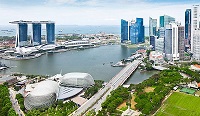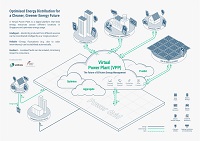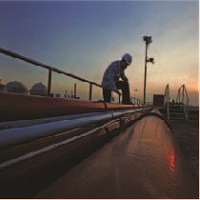For more information, please refer to:
Introduction
Mr. Chairman, I want to thank members for their interventions and I would address their questions in three broad areas – research and development, tourism, and energy.
(B) RESEARCH & DEVELOPMENT
R&D’s benefits
Dr Muhammad Faishal Ibrahim asked how we plan to harness innovation for growth, and what benefits will accrue to researchers, industries and entrepreneurs. Our investment in R&D is really part of building our long-term capabilities to build for underpin our future economic growth. It has strengthened our economy by promoting innovation and catalysing new areas of growth. So, for example, A*STAR’s Bioprocessing Technology Institute, has helped to seed the capabilities and the expertise that has supported subsequently, the emergence of the biologics industry in Singapore. And today, that industry has attracted more than S$2 billion in investments and will create more than 1,000 jobs.
Our SMEs have also gained from our R&D initiatives. Under A*STAR’s GET-Up (Growing Enterprise through Technology Upgrading) programme, researchers have been attached to some 200 SMEs to help develop new products and services by using technology. One example is Tru-Marine Pte Ltd which developed a new process to repair rather than replace worn engine rotors. This allowed the company to offer a new niche service, and it has grown its annual revenue consequently from $20 million to $50 million.
R&D for growth
Our commitment to research and innovation remains unstinting. Last year, the Prime Minister announced the Research, Innovation and Enterprise (RIE) 2015 plan, which will render enhanced support to our researchers, industries and entrepreneurs. As many members have already noted, the Government will invest $16.1 billion in R&D over the next five years, and that is an increase of 20 per cent over the previous five-year plan. At a time when many countries are cutting back on R&D due to fiscal constraints, Singapore stands out for continuing to build its research and innovation ecosystem. This investment will yield three main benefits – scientific excellence and talent; greater economic outcomes; and solutions for challenges that Singapore faces.
Supporting Excellent Science
RIE 2015, first of all, will continue to support scientific excellence and nurture talent. We will invest in the creation of new knowledge and ideas which are the basis of future innovations. The pool of competitive research funding will be enlarged to ensure that the best ideas are supported. Multi-disciplinary and collaborative efforts will be encouraged as it is often at the intersection of these different branches of knowledge that new ideas and discoveries are made.
Greater Economic Outcomes
Second, we will leverage on our scientific capabilities to generate greater economic outcomes. Under EDB’s Research Incentive Scheme, $2.5 billion will be set aside to co-fund the establishment of corporate centres of R&D excellence in Singapore. We have also introduced a new $1.35 billion Industry Alignment Fund for collaboration between public and industry researchers, in order to align Government-funded research more closely with industry needs.
Over the next 5 years, the allocation to innovation and enterprise will be doubled to $1 billion to enable researchers and entrepreneurs to take more ideas from research to commercialisation. For example, the Singapore Institute of Manufacturing Technology received a grant to further existing nanotechnology research and develop a new process for producing self-cleaning paint. This technology was licensed to Haruna Singapore Pte Ltd, a local paint company, for commercial production. And, this budget will help to match the commercial needs of companies like Haruna with the intellectual property developed in our research centres; it will support entrepreneurs in prototyping and test-bedding new products and services, and provide seed funding for growing technology enterprises.
R&D for social and environmental needs
Third, R&D will help to address some of Singapore’s pressing challenges. Ms Penny Low has suggested that Government adopt a broader definition of innovation that delivers not only economic outcomes but also solutions that address social concerns. I am assuming the member does not think that the pursuit of economic outcome is inherently wrong in its own terms. This is more about the remit that MTI and its agencies have, which is primarily to focus on economic outcomes. The dichotomy between social and economic in some ways is a false one because most of the commercially viable ideas start by seeking to address a need in the market which is a social one usually. So this is the Government’s approach. We want to encourage research which is geared towards meeting needs that are pressing, but are long-term in nature for the market and society.
We established the $1 billion National Innovation Challenge programme to encourage as Ms Penny Low put it, “systemic innovation” to develop solutions to Singapore’s national challenges. It will not only help solve our problems but also serve to build a better life for Singaporeans, and spawn new industries and business opportunities in the process. The first Challenge, “Energy Resilience for Sustainable Growth,” aims to develop cost-competitive energy solutions for deployment within 20 years to help Singapore improve energy efficiency, reduce carbon emissions, and increase energy options. The Government has also applied the collaborative innovation approach to address longer-term public sector needs. The $450 million Co-Innovation Partnership Programme will help private enterprises to collaborate with the public sector to develop innovative solutions for specific needs in the public sector. Each collaboration can receive up to $1.75 million under the programme. And there is a good pipeline of such projects. For example, the Ministry of Health is exploring ways to use remote technology to monitor diabetic patients. JTC is looking at how we can transform excavated soft material into alternative reclamation fill.
In general, we agree with Mr Wee Siew Kim’s that innovation should be encouraged in as many sectors as possible. We have established grant schemes for test-bedding ventures in areas such as urban solutions, health & wellness, lifestyle and media amongst others. And we will continue to encourage this diversity and vibrancy in our R&D landscape.
TOURISM
2010 - A year of strong recovery
Turning to tourism. As with R&D, we are breaking new ground in tourism. Last year, riding on the Asia’s recovery and the opening of the two Integrated Resorts (IRs), we welcomed 11.6 million visitors and registered $18.8 billion dollars in tourism receipts, an increase of 20 per cent in visitor arrivals from the year before and 49 per cent for tourism receipts.
Contribution of the IRs
Dr Lam Pin Min and Ms Indranee Rajah have asked about the long-term economic impact of the IRs. MTI recently announced that based on initial numbers, we are on track to realise the previously projected $2.7 billion in value-add per year per IR, and 50,000 to 60,000 economy-wide job creation in the steady state. Mr Chan asked how much of last year’s growth is due to the IRs. It is not possible to give you a definitive breakdown, but clearly there are many factors at play, starting from the low base in 2009; there is also the growth in Asia in general, and there was therefore much greater tourism traffic and there were the IRs who brought in a significant addition to our tourism landscape. But we must recognise that is early days yet with the IRs in their first year of operations. We must expect that the novelty will diminish even as the IRs continues to roll out new attractions. We must also anticipate increasing regional competition for the tourism dollar. So, it is really too early to draw definitive conclusions about their long term economic impact or, indeed, to form a view as to whether we should have more IRs in the future.
Dr Lam Pin Min and Mr Chan Soo Sen have asked about the outlook for the tourism industry. For 2011, STB’s forecast is for 12 to 13 million visitor arrivals and $22 to $24 billion in tourism receipts. That is an increase in visitor arrivals that range between 3 to 12 per cent and 17 to 28 per cent in tourism receipts. These are significant increases and they achieve, this will take us one step closer towards achieving STB’s target of 17 million tourist arrivals and $30 billion in tourism receipts in 2015.
The reason we have been able to come so far in tourism is partly because of our investments in a strong portfolio of attractions and that has helped us well to tap the growth in Asia. We’ve heard these attractions, the International Cruise Terminal, Gardens by the Bay, and the National Art Gallery – these are some of those coming on in the pipeline and will add to the momentum. Eco-tourism is not the strongest suite of most cities (including Singapore), but tourists who are so inclined can immerse themselves in the verdant environment of the Bukit Timah and Central Catchment Nature Reserves, as well as the Sungei Buloh Wetland Park. It is not really the central prong on which that STB markets Singapore as a tourist destination. But clearly, Singapore can be a launch pad from which to explore those options in the region.
Mr Chan asked about cultural tourism and STB is working on curating a diverse calendar of events ranging from lifestyle events such as the F1 and the Asian Fashion Exchange, to cultural experiences such as the Chingay Parade, Thaipusam, and Hari Raya Celebrations.
Achieving Sustained Growth in Tourism
Taking a longer term perspective of our tourism industry, we must acknowledge the constraints on our resources, especially land and labour. We cannot keep increasing indefinitely the number of visitor arrivals, which Dr Lam described as massive, or the number of workers in our tourism industry. We need to place greater emphasis on increasing the value-add derived from each visitor and raising productivity.
To raise the yield per visitor, we need to offer a great experience and greater value. For example, STB has made a deliberate effort to create a series of lifestyle events around the F1 season. Consequently, the F1 visitor’s average spending in 2010 was close to four times that of regular visitors –more spent on entertainment, F&B and accommodation. Another way to add value, and Minister has elaborated on this already, is to meet the rising expectations of our visitors and to enhance service quality. Our GEMs (Go the Extra Mile for Services) effort is part of a broader effort to raise service standards.
Productivity push is key. We’ve had a lot of discussion on it. I just want to make the point that we need to explore ways to enhance efficiency and job redesign. For example, Swissôtel the Stamford has a programme where selected room attendants are given the additional responsibility of preparing the rooms according to specified individual preferences to enhance guest experience. They are also entrusted to do their own quality control check to ensure that cleanliness and all other expectations are met. By empowering room attendants, imbuing them with greater pride and ownership in their work, and increasing job value and wages, this programme should help to increase job satisfaction and improve staff retention.
We also encourage businesses to identify areas where such improvements can be made.
ENERGY
We now turn to energy. Even as we pursue growth, we are mindful of the resource challenges that we face. Ms Jessica Tan, Mr Michael Palmer, Mr Liang Eng Hwa, and Ms Indranee Rajah have all raised questions over the impact of the political turmoil in the Middle East and North Africa on our energy prices and security.
Global Market Volatility
It is important that we first recognise that rising energy prices are part of a long-term trend which reflects fundamental demand and supply drivers in the global energy market. Barring major shifts in the global energy supply, energy will become a relatively scarce resource as demand grows, particularly because a resurgent Asia. If there is a global initiative to price the cost of carbon emissions to the environment, this will exert further upward pressure on energy prices. As a small economy almost wholly reliant on imported energy, we cannot be insulated from these global trends.
Against the backdrop of that long term trend, we must also be prepared for greater volatility in energy markets. In 2008/9, the Global Financial Crisis created demand uncertainty and depressed energy prices. Today, the turmoil in the Middle East and North Africa has created supply uncertainty. It does not affect us directly as our energy sources are primarily in our own region. But, oil futures have risen by about 21 per cent since the protests in Egypt began. Not all of these will translate to our electricity prices: the strength of the Singapore dollar, our use of natural gas as our primary fuel and efficient CCGT plants which are very efficient for power generation, and a competitive electricity market will cushion us to some extent. But we cannot be fully shielded from the impact of these increases, if they persist.
Exploring Alternative Fuels
Diversification is key to ensuring that Singapore continues to have secure and competitively priced energy supplies. The Government will, therefore,
continue to explore the development of viable alternative fuel sources. We now import gas from Malaysia and Indonesia through pipelines. We are building the LNG, terminal which will provide access to a global gas market. The terminal will come on stream in 2013.
Other options include coal and electricity imports. Coal is relatively abundant, and new technologies can help to reduce its environmental impact, so this is something which we should keep a close watch on. The Economic Strategies Committee recommended electricity imports as another possibility. A competitive proposal might allow us to access energy sources in our region while freeing up valuable land and other resources in Singapore. We are reviewing our regulatory framework to explore this option for the medium-term.
MTI is also leading a multi-agency pre-feasibility study on nuclear energy. The study is looking at key factors such as technological developments, safety and security issues, as well as the economics of nuclear energy. The aim is to inform the Government’s understanding of the risks and possibilities arising from nuclear energy, given the global and regional developments in this space. We cannot rely extensively on alternative energy options such as wind, geothermal or solar to meet our baseload energy requirements due to our natural disadvantages in these areas. But we will augment our fuel mix with these options where it is technically feasible and economically viable. For example, the Government has invested S$31 million in a pilot programme to install solar panels on the roof-tops of some HDB buildings by 2015 to assess their efficacy.
Enhancing Energy Efficiency
While we are somewhat constrained on the supply side, we can help ourselves significantly by using energy more efficiently. We can do more using less energy. The private sector has shown this. For example, since 2000, 3M has undertaken a concerted effort to inculcate in its employees an energy-efficient culture in its manpower team and as a result, they have achieved a 35 per cent improvement in energy efficiency, with a cumulative cost saving of US$1.4billion. We can aspire to do the same – as households, companies and as a nation as a whole.
The key aspect of managing demand is pricing energy right. Consumers will adjust their behaviour when they appreciate the full cost of energy as reflected in its price. Conversely, subsidising energy will only lead to inefficient use of a scarce and precious resource.
Some households may face difficulties in coping with rising and volatile energy prices. Our approach is to provide targeted assistance to those who need it. In Budget 2011, the Finance Minister has announced $200 million in utilities rebates, which will help Singaporeans cope with high energy prices. To put it in more specific terms, this year, a 1-room household will receive enough in rebates to cover most of its annual electricity bill, while a 3-room household will receive about 5 months’ worth of electricity bills in rebates. So these are significant rebates which are provided in a targeted manner, to those who will need them the most. Since 2007, the Government has provided close to $800 million of such rebates, benefitting about 800,000 households.
Clearly beyond households, we want to encourage energy efficiency amongst all industry players, across sectors, and the Energy Efficiency Programme Office (E2PO) co-ordinates these programmes.
Ms Indranee Rajah asked about the electric vehicle (EV) pilot project. This is another R & D initiative. The project will test if EVs can become a viable mode of transport in Singapore. We are currently developing the charging infrastructure for the pilot. The first charging stations are due to be completed by mid 2011. The first EVs should arrive in Singapore around that time. We will run the pilot for two years, and use the data to evaluate the costs and benefits of EVs.
CONCLUSION
Mr Chairman, if I may conclude, as Minister had emphasised earlier, growing the economy requires efforts at various levels. First, we must build capabilities: R&D is one of the ways in which MTI does this. Second, we must seize opportunities in a rising Asia: MTI’s efforts in tourism seek to do this. Third, we must address our resource constraints: MTI’s multi-pronged approach to addressing our energy challenge will help put the economy on the path of more sustainable growth.
Thank you.















